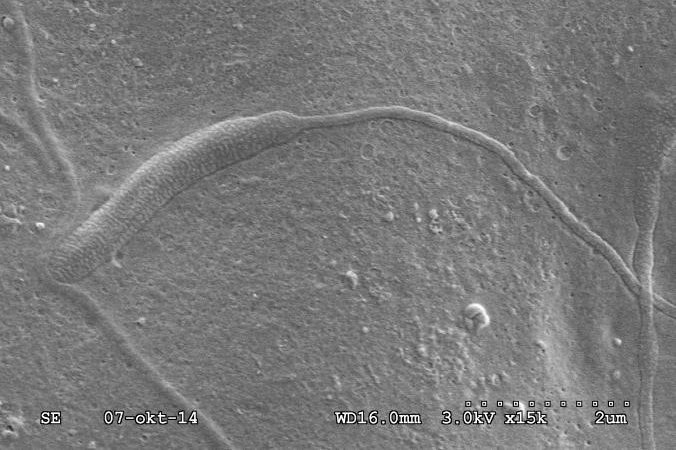What 50-million-year-old worm sperm looks like -- the oldest sperm in the world. Photo by the Swedish Museum of Natural History
STOCKHOLM, Sweden, July 15 (UPI) -- A team of German and Swedish researchers say they didn't mean find the oldest sperm in the world; it was an accident.
That's what everyone says. No one admits to be searching for really old sperm. But then history is made, and it's all over the homepage of the science journals Biology Letters and Nature.
The ancient sperm, estimated to be 50 million years old, was found inside a fossilized worm cocoon retrieved from Seymour Island in the Antarctic.
"A 50-million-year-old worm sperm from Antarctica?" Benjamin Bomfleur, a scientists with the Swedish Museum of Natural History, told The Washington Post, laughing off the discovery. "Who would have thought that's possible?"
Bomfleur and his colleagues claim they were just looking small mammal bones. Right.
As to who left behind their sperm to befuddle and embarrass serious-minded scientists 50 million years later, researchers don't know. The culprit is an ancient worm of some kind, but worms don't fossilize well. All that was found was sperm and cocoon.
But the sperm itself was fragmented, making analysis difficult. Still, the managed some educated guesses.
When the compared the characteristics of the cocoon to living worms, the scientists determined the ancient sleeping bag likely housed an early species of annelids, a group that includes modern day earthworms and leeches.
The fragmented sperm most closely resembled the sperm of the modern crayfish worm, a tiny leech-like crawlers that attach themselves to the shells of crayfish and feed on decaying organic matter.
"Surprisingly, modern crayfish worms are only known from the Northern Hemisphere," study co-author Steve McLoughlin, a senior curator at SMNH, told National Geographic. "If our identification is correct then it implies that this group of animals had a much greater geographic range [50 million years ago] than they do today."
Researchers say their 'accidental' find has opened up a new world of discovery. Worm fossils are been largely ignored, but are abundant in some places. And their insides could reveal more than just sperm.
"We have collections of fossil cocoons from several other parts of the world that we will be investigating in the future to see if they also contain sperm cells or other trapped micro-organisms," McLoughlin said.
"I think we might have a really interesting system here that can be sort of a hidden window to the past," Jakob Vinther, an expert on invertebrate evolution at the University of Bristol, but who wasn't involved in the study, told Nature. "There could be a lot of potential hidden gems inside those cocoons."















